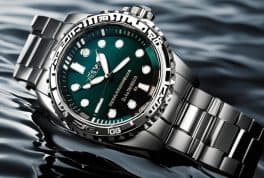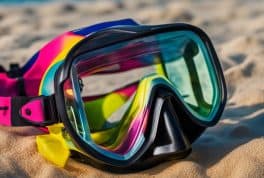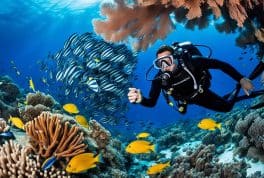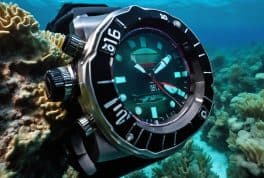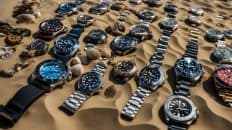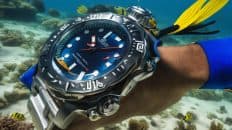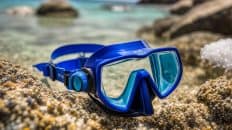Best Diving Spots in the Philippines
These are the Best Diving Spots and the Best Gear to Get You There!
Explore the Best Diving Spots in the Philippines! Known for its rich marine life and stunning underwater scenery, the Philippines is a diver's dream. Our guide highlights the top destinations, from the majestic Tubbataha Reefs to the vibrant coral gardens of Apo Island. Suitable for divers of all levels, these spots promise encounters with diverse marine species and breathtaking coral formations. Dive in and discover the Philippines' underwater marvels!Are you ready to dive into a world of awe-inspiring beauty and vibrant marine life? Look no further than the stunning diving destinations in the Philippines. With its crystal-clear waters and breathtaking underwater landscapes, the Philippines is a paradise for divers of all levels. But which are the best diving spots in this tropical archipelago?
From the highest biodiversity of Tubbataha Reefs Natural Park to the mind-blowing sardine baitball in Moalboal, there's something for every diver's preference and sense of adventure. Whether you're a macro photography enthusiast, a wreck diving aficionado, or simply looking to explore the colorful wonders of coral reefs, the Philippines has it all.
In this article, we'll take you on a journey through the top diving destinations in the Philippines, showcasing the unique experiences and hidden gems that await you. Get ready to dive deeper and discover what makes these dive spots so special.
Key Takeaways:
- The Philippines offers some of the best diving spots in the world, with diverse underwater landscapes and marine life.
- Tubbataha Reefs Natural Park boasts the highest biodiversity in the country, making it a must-visit for nature enthusiasts.
- Anilao, Batangas is renowned for its muck diving and macro photography opportunities, attracting underwater photographers from around the globe.
- Dauin, Dumaguete provides the perfect combination of luxury accommodations and world-class diving, with its proximity to Apo Island's marine sanctuary.
- Moalboal is famous for its mesmerizing sardine baitball, where divers have the chance to witness millions of sardines forming massive swirling schools.
Now, let's embark on a captivating underwater adventure as we explore the best diving spots the Philippines has to offer.
Tubbataha Reefs Natural Park - Highest Biodiversity
Tubbataha Reefs Natural Park, located in Palawan, is considered one of the best diving spots in the Philippines. As a UNESCO World Heritage Site, it offers a remarkable underwater experience with the highest biodiversity in the country.
Explore the pristine coral reefs of Tubbataha, home to a diverse range of marine species. From sharks to dolphins and turtles, you'll encounter a captivating array of marine life at every turn.
Dive into crystal-clear waters and marvel at the vibrant colors and teeming marine ecosystem. Tubbataha boasts breathtaking dive sites that will leave you in awe of nature's wonders.
Be prepared to be surrounded by an underwater paradise where biodiversity flourishes at its best.
Tubbataha Reefs Natural Park is a true gem for divers seeking the best of the Philippines' underwater world. Its majestic coral reefs and rich marine life create an unforgettable experience. It's no wonder Tubbataha is considered one of the top diving destinations in the country.
Experience the Highest Biodiversity
At Tubbataha Reefs Natural Park, you'll encounter an extraordinary range of marine species. The park is home to over 600 fish species, 360 coral species, and 11 shark species, making it a haven for underwater photographers and marine enthusiasts.
| Highlights of Tubbataha Reefs Natural Park | Marine Life | Features |
|---|---|---|
| 1. Pristine Coral Reefs | Colorful coral formations, sea fans, and sponges | Diving paradise for coral enthusiasts |
| 2. Sharks and Rays | White-tip reef sharks, hammerhead sharks, manta rays | Thrilling encounters with these majestic creatures |
| 3. Turtles | Hawksbill and green turtles | Opportunity to swim alongside these gentle giants |
| 4. Whales and Dolphins | Pilot whales, bottle-nose dolphins | A chance to witness these spectacular marine mammals |
Explore the vibrant marine ecosystem of Tubbataha Reefs Natural Park and witness the rich biodiversity that thrives in these protected waters.
Anilao, Batangas - Best Muck Diving
Anilao, located in Batangas, is considered one of the best destinations for muck diving in the Philippines. With its diverse marine ecosystem and excellent visibility, Anilao offers a spectacular experience for underwater photographers and macro enthusiasts.
The waters of Anilao are teeming with a wide array of rare critters, making it a haven for macro photography. From colorful nudibranchs and flamboyant cuttlefish to tiny seahorses and elusive frogfish, Anilao provides endless opportunities to capture stunning close-up shots of these fascinating creatures.
Aside from its reputation as a top spot for muck diving, Anilao also boasts beautiful coral reefs that are home to a variety of larger marine species. Divers can encounter schools of fish, vibrant reef fish, and even occasional sightings of turtles or reef sharks.
Anilao offers a range of dive sites suitable for all levels of experience. Whether you're a beginner or an advanced diver, there are sites with varying depths and currents to explore. Many dive operators in Anilao provide guided dives and underwater photography services, ensuring a memorable and rewarding experience for every diver.
"Anilao is a paradise for underwater photographers. The macro opportunities here are unparalleled, and the colorful critters will leave you in awe. It's a must-visit destination for anyone passionate about underwater photography."
If you're planning a trip to Anilao, make sure to bring your macro lens, a good strobe, and plenty of memory cards. Be prepared to spend hours exploring the fascinating macro world hidden beneath the waves. With its incredible biodiversity and outstanding muck diving experience, Anilao is a gem waiting to be discovered by underwater photography enthusiasts.
Next, let's delve into another incredible diving destination in the Philippines - Dauin, Dumaguete.
Dauin, Dumaguete - All-In-One Luxury Destination
Dauin, near Dumaguete, is a luxury dive destination that offers a range of diving experiences. Located in the heart of the Philippines, this picturesque coastal town is the perfect destination for a luxury dive vacation.
Dauin: Nestled along the coast of Negros Oriental, Dauin is famous for its stunning dive sites and pristine beaches. This idyllic town boasts crystal-clear waters, vibrant coral reefs, and an abundance of marine life, making it a paradise for divers.
Dumaguete: Just a short drive from Dauin, Dumaguete is a charming university city known for its friendly locals and vibrant culture. With its relaxed atmosphere and stunning views of the sea, Dumaguete offers the perfect setting for a luxury escape.
Diving in Dauin:
Dauin is renowned for its proximity to Apo Island, a marine sanctuary that attracts divers from around the world. Apo Island is home to a rich biodiversity, including colorful coral gardens and a thriving sea turtle population. Divers can explore the underwater world and marvel at the stunning marine life that calls this sanctuary home.
Luxury Accommodations: Dauin offers a range of luxury accommodations that cater to the discerning diver. From boutique resorts with private villas to luxurious beachfront hotels, you'll find the perfect place to relax and unwind after a day of diving.
World-Class Dive Operators: Dauin is home to several world-class dive operators that provide exceptional service and personalized dive experiences. Whether you're a beginner or an experienced diver, these dive operators will ensure that your dives in Dauin are safe, memorable, and filled with incredible underwater encounters.
Exploring Dauin:
While diving is the main highlight in Dauin, there is plenty to see and do on land as well. Take a leisurely stroll along the white-sand beaches, indulge in delicious local cuisine, or immerse yourself in the warm hospitality of the locals.
"Dauin offers the perfect blend of luxury accommodations, world-class diving, and breathtaking natural beauty. It's a destination that truly caters to the discerning diver looking for an all-in-one luxury experience."
| Highlights | Luxury Accommodations | Dive Operators |
|---|---|---|
|
|
|
With its luxurious accommodations, world-class diving, and proximity to a marine sanctuary, Dauin is the ultimate all-in-one luxury destination for divers seeking a truly unforgettable experience.
Moalboal, Cebu - Mind-Blowing Sardine Baitball
Unleash your sense of wonder in Moalboal, a captivating diving destination located in the stunning province of Cebu. Prepare to be amazed as you dive into the depths of the sea and witness the mind-blowing spectacle of the sardine baitball. This awe-inspiring natural phenomenon features millions of sardines swirling together in massive schools, creating a mesmerizing display of movement and unity.
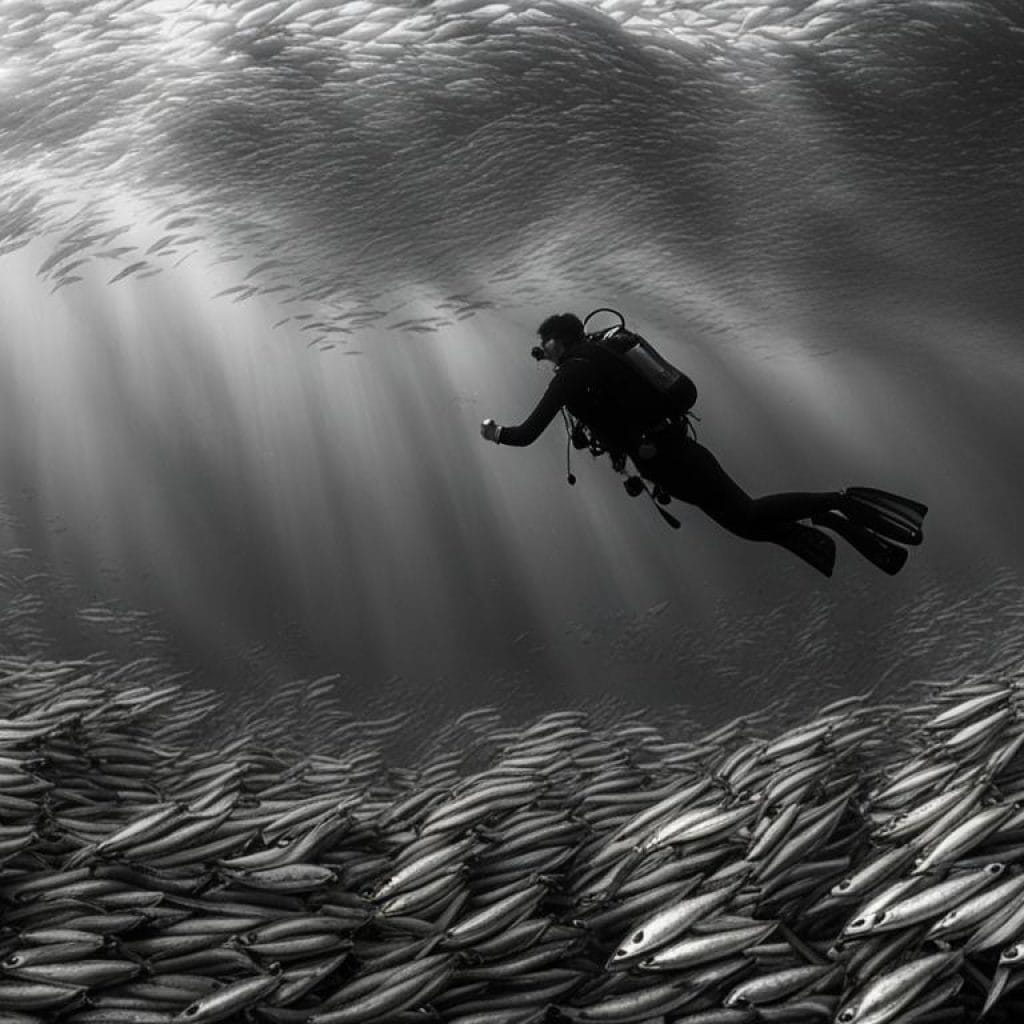
Immerse yourself in the midst of this incredible underwater show as the sardines move in perfect harmony, glistening under the warm tropical sun. The sight of these shimmering silver fish creating intricate formations is a diving experience like no other.
But the sardine baitball is just the beginning of Moalboal's underwater wonders. Explore the breathtaking coral reefs teeming with vibrant marine life, from colorful tropical fish to graceful sea turtles. Dive deep into the clear waters and discover the hidden gems of Moalboal's underwater world.
Whether you're an experienced diver or new to the world of underwater exploration, Moalboal offers an unforgettable diving experience. The friendly local dive operators and well-preserved dive sites ensure that diving in Moalboal is safe, enjoyable, and suitable for divers of all levels.
So pack your dive gear and get ready to be amazed by Moalboal's sardine baitball and the enchanting beauty that lies beneath the surface. Prepare for a dive adventure of a lifetime in this exceptional diving destination in Cebu.
Puerto Galera, Mindoro - Beautiful Beaches + Diverse Dives
Puerto Galera, located on the stunning island of Mindoro, is a true paradise that offers an exquisite blend of pristine beaches and diverse diving opportunities. Nestled near the renowned Verde Island Passage, which is known for its extraordinary biodiversity, Puerto Galera attracts divers from around the world eager to explore its vibrant underwater world.
With its crystal-clear waters and colorful coral reefs, Puerto Galera is a haven for marine enthusiasts. Whether you are a beginner or a seasoned diver, this tropical destination offers a wide range of dive sites suitable for all experience levels. From exhilarating drift dives to tranquil shallow reefs, Puerto Galera guarantees an unforgettable underwater adventure.
One of the standout features of diving in Puerto Galera is its incredible marine biodiversity. The Verde Island Passage, often referred to as the 'Center of the Center of Marine Biodiversity,' is a sanctuary for a vast array of marine species. Divers can encounter colorful tropical fish, majestic sea turtles, playful dolphins, and even the elusive seahorses that have made this region their home.
For those seeking a more adrenaline-filled experience, Puerto Galera offers unique opportunities for drift diving. The strong currents in certain areas create an exhilarating ride as divers glide through the water, witnessing the stunning marine life that thrives in the rich currents. It's an adventure like no other!
"Puerto Galera's beautiful beaches and diverse dives make it a must-visit destination for any diving enthusiast. From the moment you set foot on its shores, you'll be captivated by the natural wonders both above and below the water."
| Highlights of Puerto Galera | Dive Sites | Marine Life |
|---|---|---|
| Beautiful sandy beaches | Sabang Wrecks | Turtles |
| Thrilling drift dives | Canyons | Dolphins |
| Colorful coral reefs | The Hole in the Wall | Seahorses |
| Diverse marine biodiversity | Batangas Channel | Reef sharks |
| Charming coastal villages | Verde Island | Macro critters |
Dive sites are subject to change based on seasonal conditions and local expert recommendations.
When you're not exploring the captivating underwater realm, you can relax and rejuvenate on Puerto Galera's beautiful beaches. Take a stroll along the powdery white sands, soak up the tropical sun, or dive into the azure-blue waters for a refreshing swim. The natural beauty of the island is sure to leave you in awe.
With its magnificent beaches and diverse dives, Puerto Galera truly offers the perfect combination for a memorable tropical getaway. Whether you are seeking relaxation or adventure, this enchanting destination will exceed your expectations at every turn.
Anda, Bohol - Bohol's Hidden Gem
When it comes to diving in the Philippines, Anda, located on the island of Bohol, is a true hidden gem. This undiscovered diving destination offers a pristine underwater world waiting to be explored. From vibrant coral reefs to diverse marine life, Anda has everything that makes it an undiscovered diving paradise.
Anda is a tranquil escape for divers seeking a quieter and more exclusive diving experience. The crystal-clear waters surrounding the island provide excellent visibility, allowing divers to fully appreciate the colorful underwater scenery. Whether you're a beginner or an experienced diver, Anda's diverse dive sites cater to all skill levels and offer something for everyone.
Explore Pristine Coral Reefs
Anda is home to an array of pristine coral reefs teeming with vibrant marine life. Dive into the depths and marvel at the intricate formations of hard and soft corals that provide a kaleidoscope of colors. Swim alongside schools of tropical fish as they dart through the coral gardens, creating a mesmerizing underwater spectacle.
Discover Abundant Marine Life
Beneath the surface of Anda's waters, you'll discover a diverse range of marine species. Encounter majestic sea turtles gracefully gliding through the sea, while seahorses and colorful nudibranchs hide amongst the coral. Keep your eyes peeled for elusive frogfish camouflaged against their surroundings, showcasing the incredible marine biodiversity of Anda.
Escape the Crowds
Unlike some of the more popular diving destinations in the Philippines, Anda remains relatively undiscovered and uncrowded. Dive sites are not overrun with tourists, allowing for a more intimate and serene diving experience. Immerse yourself in the tranquility of the underwater world, where the only sounds you'll hear are the gentle currents and your own breath.
Anda, Bohol is a hidden gem that offers pristine coral reefs, abundant marine life, and uncrowded dive sites. With its crystal-clear waters and colorful underwater scenery, it's a paradise for divers seeking a quieter and more exclusive experience.
Explore the undiscovered diving destination of Anda, Bohol, and uncover a world beneath the waves that will leave you in awe. Immerse yourself in the natural beauty, vibrant marine life, and the serenity that this hidden gem has to offer.
Malapascua, Cebu - Thresher Sharks + Macro
Malapascua, located in Cebu, is a diving paradise that offers thrilling encounters with thresher sharks and a haven for macro diving enthusiasts. The island is famous for its unique early morning dives at Monad Shoal, where divers have the incredible opportunity to witness the majestic thresher sharks up close. These graceful creatures, known for their long tails and distinctive silhouettes, gracefully glide through the crystal-clear waters, creating a mesmerizing sight that will leave divers in awe. It is truly an unforgettable experience to observe these elusive sharks in their natural habitat.
Aside from thresher sharks, Malapascua is also a haven for macro diving. The island boasts a wide array of critters that will delight underwater photographers and macro enthusiasts. From seahorses and nudibranchs to colorful frogfish, the rich biodiversity of Malapascua's underwater world is a treat for those seeking the tiniest and most intricate marine creatures. Exploring the vibrant coral reefs and searching for hidden gems during macro dives is an exploration of a truly unique and captivating underwater realm.
"Malapascua offers divers the chance to witness the beauty of thresher sharks and indulge in the art of macro photography, making it a must-visit destination for underwater enthusiasts."
To further showcase the diversity of marine life in Malapascua, here's a glimpse into the different species that divers can encounter during their underwater adventures:
| Thresher Sharks | Seahorses | Nudibranchs | Frogfish |
|---|---|---|---|
| Known for their distinctive long tails | Range from tiny pygmy seahorses to larger species | Come in a variety of colors and patterns | Camouflaged predators with unique appearances |
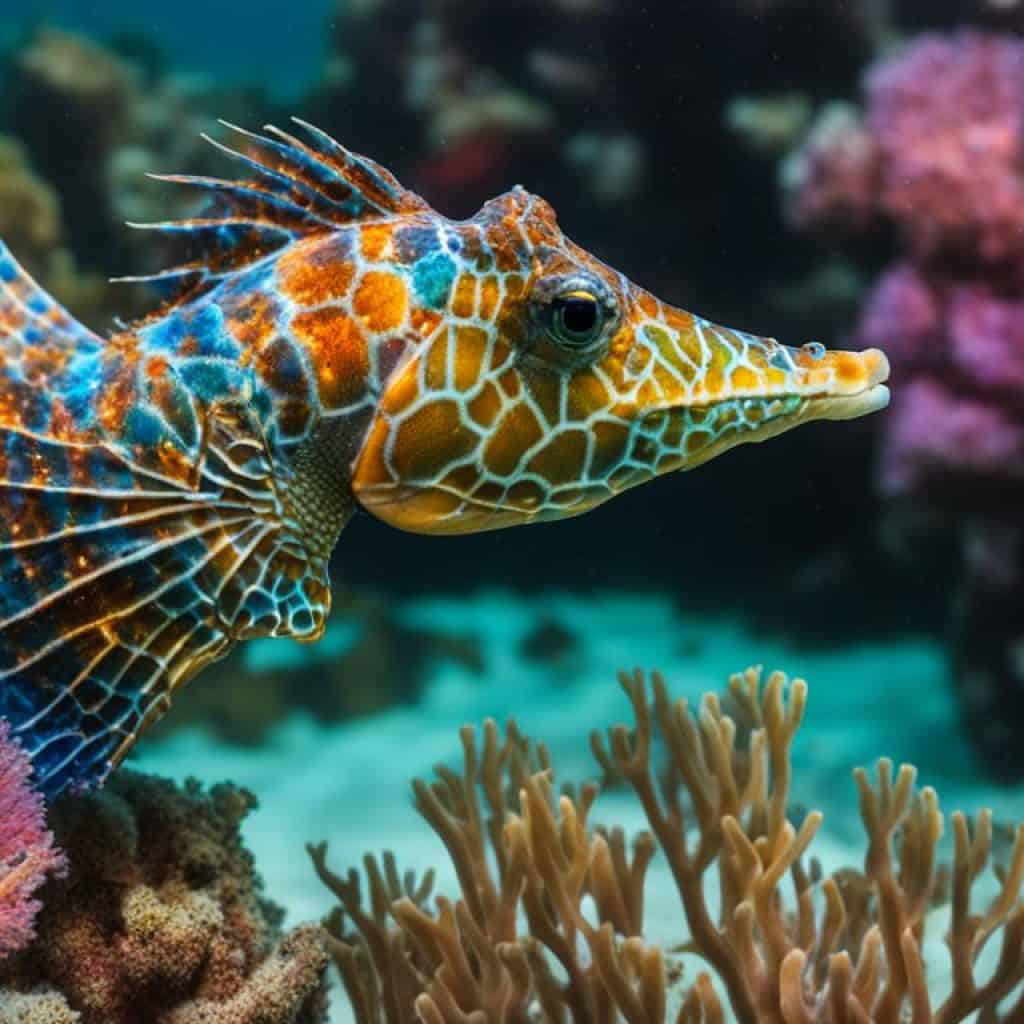 |
Exploring the underwater world of Malapascua is a truly extraordinary experience. The combination of thrilling encounters with thresher sharks and the abundance of macro life makes this island off the coast of Cebu an essential destination for divers who seek adventure and appreciate the beauty of the smallest and largest creatures beneath the surface.
Coron Bay, Palawan - Easy WWII Wreck Diving
Coron Bay, located in Palawan, is a haven for wreck diving enthusiasts. This picturesque bay is home to a number of World War II wrecks that have now transformed into captivating artificial reefs, bursting with abundant marine life.
Diving in Coron Bay offers a truly unique experience for both history buffs and adventurous divers. Explore the sunken relics of the past and witness the fascinating fusion of history and nature. As you navigate through the wreckage, you'll encounter schools of colorful fish, vibrant coral formations, and other marine creatures thriving in this underwater museum.
Unveiling the Secrets of WWII Wreck Diving
Discover the hidden stories of the vessels that once sailed these waters and gain a deeper understanding of the historical significance of Coron Bay. These submerged war memorials provide a glimpse into the past, allowing you to connect with the events that unfolded in this very spot during World War II.
"Diving in the wrecks of Coron Bay was like stepping back in time. Each wreck had its own story to tell, transporting me to a different era. It was an unforgettable experience that left me in awe of the resilience of both nature and history." - Sam, avid diver
Easy Accessibility and Diverse Dive Sites
One of the many advantages of diving in Coron Bay is the ease of accessibility to the wrecks. The majority of these fascinating dive sites are reachable by short boat rides, making it convenient for divers of all skill levels, from beginners to advanced.
Each wreck carries its own unique charm and allure, offering a variety of dive experiences. Encounter massive cargo ships, eerie submarines, and aircrafts, all resting peacefully on the ocean floor. Dive into the depths and uncover the mysteries contained within these silent witnesses of the past.
Preserving History and Marine Life
Coron Bay's wrecks not only serve as historical landmarks but also as thriving ecosystems. Over the years, these sunken relics have become artificial reefs, nurturing a diverse array of marine species. Vibrant coral formations have taken root on the metal skeletons, attracting an abundance of fish, rays, and other fascinating underwater inhabitants.
As you explore the wrecks, you'll witness firsthand how nature has reclaimed these structures, providing shelter and sustenance for an astonishing array of marine life. It's a testament to the resilience of both the ocean and its inhabitants.
A Unique Dive Adventure Awaits
Whether you're a history enthusiast, an adventurous diver, or simply captivated by the allure of underwater exploration, Coron Bay in Palawan is a must-visit destination. Immerse yourself in the rich history, vibrant marine life, and breathtaking scenery that can be found beneath the surface of this remarkable dive site.
Embark on a dive adventure unlike any other and create memories that will last a lifetime in Coron Bay, where the echoes of the past collide with the wonders of the present.
Other Great Places in the Philippines
In addition to the well-known diving destinations, the Philippines is home to many other hidden gems and lesser-known dive destinations. These off-the-beaten-path spots offer unique diving experiences away from the crowds, allowing divers to explore untouched underwater wonders.
Remote Ticao Island
Ticao Island, situated in the Bicol Region, is a remote and untouched paradise for divers. With its crystal-clear waters and vibrant coral reefs, this hidden gem is teeming with marine life. Divers can expect to encounter a variety of colorful fish species, turtles, and even occasionally spot large pelagic creatures like mantas and whale sharks.
Prima Palawan
Prima Palawan, located in the pristine waters of Palawan, is a well-kept secret among diving enthusiasts. Its untouched coral gardens and abundance of marine species make it a true paradise for underwater exploration. Divers can expect to dive surrounded by stunning rock formations, vibrant corals, and an array of fascinating marine life including seahorses, nudibranchs, and schools of tropical fish.
Secret Siargao
Siargao, known for its world-class surfing waves, also offers incredible diving opportunities. The hidden dive sites around the island are home to thriving coral reefs, underwater caves, and untouched marine ecosystems. Divers can explore beautiful walls, encounter colorful reef fish, and possibly even spot rare and elusive creatures like frogfish and seadragons.
Other lesser-known dive destinations in the Philippines include remote islands like Siquijor, Camiguin, and Dinagat, each offering unique diving experiences and untouched natural beauty. These hidden gems are waiting to be discovered by adventurous divers seeking a truly unforgettable diving adventure.
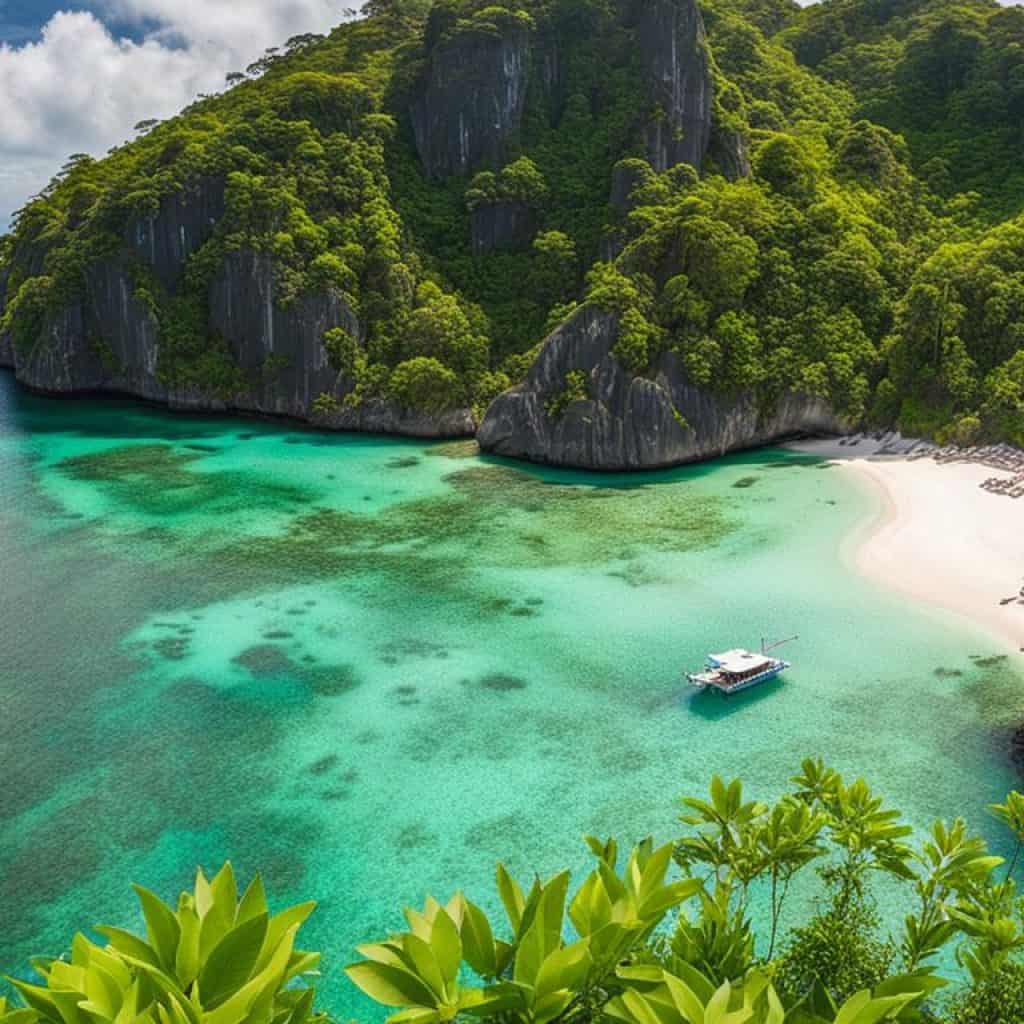
Explore the lesser-known dive destinations in the Philippines and uncover hidden gems that will leave you in awe. Dive into crystal-clear waters, swim alongside vibrant marine life, and surround yourself with untouched beauty. Discover a world underwater that few have seen before.
Best Time to Dive
When planning a dive trip to the Philippines, it's crucial to consider the best time to dive to ensure optimal conditions and maximize your underwater experience. The country offers an abundance of diving opportunities throughout the year, but certain months are more favorable than others.
The best time to dive in the Philippines generally falls between November and April. During this period, the weather is typically dry, and the chances of encountering typhoons are relatively low. The visibility is excellent, making it ideal for exploring the vibrant marine life and breathtaking underwater landscapes.
However, it's essential to note that diving seasons may vary depending on the specific destination within the Philippines. For example, Tubbataha Reefs Natural Park has a limited diving season, typically from mid-March to mid-June, due to its remote location and protected status.
To plan your dive trip effectively, research the diving seasons and weather conditions of each destination you intend to visit. This will ensure that you choose the best time to witness the spectacular marine biodiversity and enjoy the optimal diving experience.
Table: Diving Seasons and Weather Conditions by Destination
| Destination | Diving Season | Weather Conditions |
|---|---|---|
| Tubbataha Reefs Natural Park | Mid-March to Mid-June | Dry and warm |
| Anilao, Batangas | Year-round | Tropical climate; occasional rain showers |
| Dauin, Dumaguete | Year-round | Tropical climate; occasional rain showers |
| Moalboal, Cebu | Year-round | Tropical climate; occasional rain showers |
| Puerto Galera, Mindoro | Year-round | Tropical climate; occasional rain showers |
| Anda, Bohol | Year-round | Tropical climate; occasional rain showers |
| Malapascua, Cebu | Year-round | Tropical climate; occasional rain showers |
| Coron Bay, Palawan | Year-round | Tropical climate; occasional rain showers |
Each diving destination in the Philippines offers unique experiences, and understanding the diving seasons and weather conditions will help you plan your trip accordingly. Whether you're captivated by the rich biodiversity of Tubbataha Reefs or the stunning reefs of Anilao, diving in the Philippines promises an unforgettable adventure.
Flight Information
When planning your diving trip to the Philippines, it's essential to have the necessary flight information. The country has several international airports, but the main gateway for most international flights is Manila International Airport. From here, you can easily connect to your chosen diving destination within the country.
For domestic flights, there are several airlines that operate domestic routes in the Philippines, including Philippine Airlines, Cebu Pacific, and AirAsia Philippines. These airlines offer frequent flights to popular diving destinations, ensuring convenient travel options for divers.
To secure the best availability and connections for your diving trip, it is advisable to book domestic flights in advance. This will not only save you time but also ensure a smooth and hassle-free travel experience.
International Airports in the Philippines:
- Ninoy Aquino International Airport (MNL) - Manila
- Mactan-Cebu International Airport (CEB) - Cebu
- Clark International Airport (CRK) - Angeles City
- Francisco Bangoy International Airport (DVO) - Davao
- Iloilo International Airport (ILO) - Iloilo City
Domestic Airports near Diving Destinations:
Here are some of the domestic airports near popular diving destinations in the Philippines:
| Diving Destination | Nearest Domestic Airport |
|---|---|
| Tubbataha Reefs Natural Park | Francisco Reyes Airport (USU) - Coron, Palawan |
| Anilao, Batangas | Francisco Reyes Airport (USU) - Coron, Palawan |
| Dauin, Dumaguete | Sibulan Airport (DGT) - Dumaguete City |
| Moalboal, Cebu | Mactan-Cebu International Airport (CEB) - Cebu |
| Puerto Galera, Mindoro | Ninoy Aquino International Airport (MNL) - Manila |
| Anda, Bohol | Tagbilaran Airport (TAG) - Bohol |
| Malapascua, Cebu | Mactan-Cebu International Airport (CEB) - Cebu |
| Coron Bay, Palawan | Francisco Reyes Airport (USU) - Coron, Palawan |
Remember to check the flight schedules and availability as some destinations may have limited flight options. By planning ahead and knowing your flight options, you can ensure a seamless journey to your dream diving spot in the Philippines!
Considerations for Dive Accommodations
When planning a dive trip to the Philippines, it is important to consider the type of accommodations that best suit your diving needs. Choosing the right dive accommodations can enhance your overall diving experience and provide a comfortable base for your underwater exploration.
There are three main types of dive accommodations to consider:
- Dive Resorts
- Liveaboards
Dive Resorts
Dive resorts are a popular choice for divers as they offer convenient access to dive sites and often have dedicated facilities and services tailored to divers. These resorts are located in close proximity to dive sites, making it easy to jump straight into the water and explore the underwater wonders. Many dive resorts also provide equipment rental, guided dives, and dive training for divers of all skill levels.
If you prefer the convenience of having everything in one place, a dive resort is a great option. You can find a range of dive resorts across the Philippines, catering to different budgets and preferences.
Liveaboards
For a more immersive diving experience, consider a liveaboard trip. Liveaboards are boats or yachts specifically designed for diving adventures and offer the opportunity to explore multiple dive destinations during your trip. These trips often take you to remote and pristine dive sites that are not easily accessible from shore.
Liveaboards provide all-inclusive dive packages, including accommodation, meals, and guided dives. These trips typically offer a more relaxed diving schedule, allowing divers to fully immerse themselves in the underwater world. Liveaboard trips range from a few days to several weeks, offering a unique and unforgettable diving experience.
"Liveaboard trips take you to remote and pristine dive sites, providing an unparalleled underwater adventure."
Before booking a liveaboard trip, it is important to consider factors such as the itinerary, dive requirements, and comfort level onboard. Research different liveaboard options to find one that aligns with your diving preferences and budget.
Comparison of Dive Accommodations
| Dive Accommodations | Key Features | Pros | Cons |
|---|---|---|---|
| Dive Resorts | Convenient access to dive sites Dedicated facilities and services for divers | Easy access to dive sites Opportunity for shore dives Guided dives and equipment rental available | May be more crowded Limited dive sites available depending on location |
| Liveaboards | Explore multiple dive destinations All-inclusive dive packages Relaxed diving schedule | Access remote and pristine dive sites Immersive diving experience Opportunity to meet other divers | Restricted by set itineraries May have limited non-diving activities Higher cost compared to resorts |
Table: Comparison of Dive Accommodations
When choosing between dive resorts and liveaboards, consider your diving goals, budget, and travel preferences. Both options offer unique advantages and ultimately depend on your personal preferences and priorities for your dive trip.
Whichever dive accommodations you choose, make sure to book in advance to ensure availability during your desired travel dates. Dive resorts and liveaboards can fill up quickly, especially during peak diving seasons.
Tips for a Memorable Dive Trip
To make your dive trip in the Philippines truly memorable, there are a few tips to keep in mind. Prioritize dive safety by following the guidelines and instructions of your dive operator or guide. Remember, safety always comes first when exploring the underwater world.
Here are some essential diving tips:
- Stay within your comfort zone: When planning your dive, choose dive sites and conditions that match your skill level and experience. Don't push yourself beyond your limits.
- Check your equipment: Before every dive, ensure that your dive gear is in good working condition. Check your regulator, BCD, and dive computer or watch to make sure everything is functioning properly.
- Plan your dives: Discuss dive plans with your dive buddy or group. Agree on maximum dive depths, dive times, and safety stops. It's always better to have a plan in place.
- Stay hydrated: Drink plenty of water before and after your dive to stay hydrated. Dehydration can increase your risk of decompression sickness.
- Practice good buoyancy control: Mastering buoyancy control is essential for conserving energy, protecting the marine environment, and capturing great underwater photos. Maintain neutral buoyancy and avoid touching or damaging delicate coral reefs.
- Respect marine life: Remember to maintain a safe distance from marine creatures and avoid disturbing their natural habitat. Never touch or chase marine life, as it can cause stress and harm to the animals.
- Underwater photography: Consider taking an underwater photography course to capture stunning images of your dive adventures. Learn about composition, lighting, and how to handle your camera underwater.
- Log your dives: Keep a logbook of your dive experiences, including dive sites, depths, and any notable marine life sightings. It will serve as a valuable record of your dives and help you track your progress as a diver.
- Enjoy the moment: Finally, remember to relax, enjoy, and appreciate the beauty of the underwater world. Take your time to observe the marine life, soak in the breathtaking views, and create memories that will last a lifetime.
By following these diving tips, prioritizing dive safety, and indulging in underwater photography, you'll have a truly memorable and fulfilling dive trip in the Philippines.
Conclusion
In conclusion, the Philippines offers a treasure trove of diving opportunities that are sure to leave divers of all levels awestruck. With its stunning coral reefs, diverse marine life, and unique underwater landscapes, this country is a dream destination for any diving enthusiast. From the highest biodiversity at Tubbataha Reefs Natural Park to the mind-blowing sardine baitball in Moalboal, each diving spot in the Philippines has its own special charm.
Whether you're seeking macro photography opportunities in Anilao, luxury diving experiences in Dauin, or thrilling encounters with thresher sharks in Malapascua, the Philippines caters to all diving preferences. Moreover, the lesser-known destinations like Anda and Coron Bay offer hidden gems waiting to be explored, promising uncrowded dive sites and unspoiled beauty.
With a favorable diving season between November and April, along with convenient flight connections and a variety of dive accommodations to choose from, planning your diving trip to the Philippines is made easy. Remember to prioritize dive safety, consider learning underwater photography, and savor every moment of your adventure. The Philippines is truly a diver's paradise and should not be missed. Start planning your unforgettable diving experience today!
FAQ
What are the best diving spots in the Philippines?
The Philippines has a wide range of top diving destinations, including Tubbataha Reefs Natural Park, Anilao, Dauin, Moalboal, Puerto Galera, Anda, Malapascua, and Coron Bay.
Why is Tubbataha Reefs Natural Park considered one of the best diving spots in the Philippines?
Tubbataha Reefs Natural Park is a UNESCO World Heritage Site and boasts the highest biodiversity in the country. It offers pristine coral reefs and a diverse range of marine species, including sharks, dolphins, and turtles.
What makes Anilao, Batangas a great diving destination?
Anilao is renowned for its muck diving and macro photography opportunities. The area is home to a wide array of rare critters, making it a haven for underwater photographers. Anilao also offers beautiful coral reefs and the chance to encounter larger marine species.
What can I expect when diving in Dauin, Dumaguete?
Dauin is a luxury dive destination that offers a range of diving experiences. With its proximity to Apo Island, known for its coral gardens and sea turtle population, Dauin provides a unique combination of luxury accommodations and world-class diving opportunities.
What is the highlight of diving in Moalboal, Cebu?
Moalboal is famous for its mind-blowing sardine baitball. Divers have the opportunity to witness millions of sardines forming massive swirling schools, creating a visually stunning underwater spectacle. Moalboal also offers beautiful coral reefs and the chance to encounter other marine species.
What makes Puerto Galera, Mindoro a popular diving destination?
Puerto Galera offers a perfect combination of beautiful beaches and diverse diving opportunities. With its proximity to Verde Island Passage, known for its incredible biodiversity, Puerto Galera attracts divers from around the world. From colorful coral reefs to thrilling drift dives, Puerto Galera has it all.
Why should I consider diving in Anda, Bohol?
Anda is a hidden gem when it comes to diving in the Philippines. This undiscovered diving destination offers pristine coral reefs, abundant marine life, and uncrowded dive sites. With its crystal-clear waters and colorful underwater scenery, Anda is a paradise for divers seeking a quieter, more exclusive experience.
What can I expect when diving in Malapascua, Cebu?
Malapascua is renowned for its thresher shark encounters. Divers have the unique opportunity to see these graceful creatures up close during early morning dives at Monad Shoal. In addition to thresher sharks, Malapascua offers excellent macro diving, with a wealth of critters such as seahorses, nudibranchs, and frogfish.
What makes Coron Bay, Palawan a popular diving destination?
Coron Bay is a popular destination for wreck diving enthusiasts. The bay is home to a number of easily accessible World War II wrecks, which have become artificial reefs teeming with marine life. For history buffs and adventurous divers, Coron Bay offers a unique opportunity to explore these sunken relics.
Are there any other great diving spots in the Philippines?
Yes, besides the well-known diving destinations, there are many other hidden gems worth exploring in the Philippines. From the remote Ticao Island to the pristine waters of Palawan, these lesser-known dive destinations offer unique diving experiences away from the crowds.
When is the best time to dive in the Philippines?
The best time to dive in the Philippines generally falls between November and April, when the weather is dry and typhoon activity is low. However, some diving destinations have limited diving seasons, so it's important to check the specific diving seasons and weather conditions of each destination when planning a dive trip.
What are the flight options to reach the diving destinations in the Philippines?
The Philippines has several international airports, with Manila being the main gateway for most international flights. Domestic flights are available to reach the various diving destinations within the country. It is advisable to book domestic flights in advance to secure the best availability and connections for your diving trip.
What should I consider when choosing dive accommodations in the Philippines?
When planning a dive trip to the Philippines, it's important to consider the type of accommodations that best suit your diving needs. From dive resorts located near dive sites to liveaboard trips that offer the opportunity to explore multiple destinations, there are a variety of options available. Research and book accommodations in advance to ensure availability during your desired travel dates.
What are some tips for a memorable dive trip in the Philippines?
To make your dive trip in the Philippines truly memorable, prioritize dive safety by following the guidelines and instructions of your dive operator or guide. Consider taking an underwater photography course to capture the beauty of the underwater world. And most importantly, enjoy every moment of your diving adventure in the Philippines.
Source Links
- https://blog.padi.com/best-dive-sites-in-the-philippines/
- https://www.seacrush.com/en/diving/philippines
- https://www.bluewaterdivetravel.com/best-diving-in-philippines
Scuba Diving in the Philippines: An Underwater Journey
Section 1: Introduction to the Philippines' Underwater World
The Philippines, an archipelago of over 7,000 islands in the Western Pacific, beckons with its crystal-clear waters and vibrant marine life, making it a paradise for scuba divers. With its unique geographical location within the Coral Triangle, the area is recognized for having the highest coral diversity in the world. This rich biodiversity is not just a boon for marine biologists but also for scuba enthusiasts who get to explore a mesmerizing underwater world.
Section 2: The Best Dive Sites in the Philippines
Each island in the Philippines offers a unique diving experience, catering to divers of all skill levels.
- Tubbataha Reefs Natural Park: Located in the middle of the Sulu Sea, this UNESCO World Heritage site is only accessible by liveaboard. Its isolation has helped preserve its pristine condition, making it a haven for large pelagics, sharks, and vibrant coral gardens.
- Malapascua Island: Famous for its thresher shark encounters, Malapascua is a small island off the northern tip of Cebu. The Monad Shoal, an underwater plateau, is the go-to spot for seeing these elusive creatures.
- Apo Island and Dauin: Off the coast of Negros Oriental, Apo Island is a protected marine sanctuary teeming with marine life. Nearby Dauin offers excellent muck diving opportunities, with rare critters like mimic octopi and flamboyant cuttlefish.
- Coron Bay, Palawan: Known for its World War II wreck diving, Coron Bay is a historical underwater museum. The wrecks, covered in corals and teeming with fish, provide a haunting yet fascinating experience.
- Anilao, Batangas: Close to Manila, Anilao is renowned for its macro life. Photographers flock here to capture stunning images of nudibranchs, seahorses, and other small wonders.
Section 3: Marine Biodiversity and Conservation Efforts
The Philippines is a hotspot for marine biodiversity. This underwater realm is home to over 2,000 species of fish and 500 species of coral. However, this rich biodiversity is under threat from overfishing, pollution, and climate change.
Local communities, NGOs, and the government have been working on various conservation initiatives. Marine Protected Areas (MPAs) have been established, such as the Apo Island Marine Reserve, to safeguard these vital ecosystems. Dive operators and resorts are increasingly participating in conservation efforts, promoting sustainable tourism practices.
Section 4: Preparing for Your Dive Trip
Before embarking on your diving adventure, proper preparation is essential.
- Certification and Training: Ensure you are certified by a recognized diving organization. Beginners can find numerous dive centers offering PADI or SSI certification courses.
- Equipment: While most dive resorts offer rental equipment, it’s advisable to bring your own mask, snorkel, and fins for comfort. For those diving in deeper or cooler waters, a suitable wetsuit is essential.
- Insurance: Obtaining dive insurance is crucial. It covers unforeseen incidents and potential hyperbaric oxygen therapy chamber treatments - See Hyperbaric Oxygen Therapy Cost.
- Health and Fitness: Scuba diving is physically demanding. It’s important to be in good health and inform your dive instructor of any medical conditions.
Section 5: Cultural Considerations and Travel Tips
The Philippines is a melting pot of cultures, and Filipinos are known for their hospitality. English is widely spoken, making communication easy for most travelers. When visiting rural or remote areas, being respectful of local customs and traditions is important.
Regarding travel logistics, the Philippines has a tropical climate, so lightweight clothing is recommended. The best time for diving is typically from December to May, avoiding the monsoon season. Currency is the Philippine Peso, and while credit cards are accepted in urban areas, cash is king in remote locations.
Section 6: The Future of Scuba Diving in the Philippines
The future of scuba diving in the Philippines looks promising yet challenging. With increasing awareness of marine conservation and sustainable tourism, the Philippines could set a global example. However, this requires continuous efforts in conservation and education to ensure that its underwater treasures are preserved for generations to come.
Section 7: Conclusion
Scuba diving in the Philippines offers an unparalleled experience. From the thresher sharks of Malapascua to the wrecks of Coron Bay, the underwater world here is diverse and awe-inspiring. As divers, we have the responsibility to respect and protect this fragile marine environment. Immersing oneself in the depths of the Philippines is not just about adventure; it’s about connecting with nature and understanding the vital role these ecosystems play in our world.
70 Top Diving Sites in the Philippines
The Philippines, with its rich marine biodiversity and warm waters, offers a wide range of scuba diving experiences, from pristine coral reefs to WWII shipwrecks. Here's a list of some of the top diving spots in the Philippines:
- Tubbataha Reef, Sulu Sea: A UNESCO World Heritage Site known for its thriving coral reefs and abundant marine life, including whale sharks, manta rays, and sea turtles. It's only accessible by liveaboard.
- Apo Reef Natural Park: Located off the coast of Mindoro Island, this protected marine area is home to over 500 species of fish and is popular for close-up photography.
- Malapascua Island: Famous for sightings of thresher sharks, this small island in the Visayas region also offers beautiful coral reefs and a World War II shipwreck.
- Coron Bay, Calamian Islands: Known for multiple shipwrecks from World War II, now serving as artificial reefs attracting diverse aquatic life.
- Monad Shoal: A submerged island off the coast of Malapascua Island, famous for sightings of thresher sharks and popular for early morning dives.
- Anilao, Batangas: A hotspot for macro photographers, where divers can find a significant portion of the Philippines’ coral species and various small marine creatures.
- Puerto Galera, Mindoro: Offers a variety of diving environments, including reefs, drifts, and mucks, and is known for its abundant marine life.
- Balicasag Island, Bohol: Known for vibrant coral gardens and diverse marine life, including turtles and schools of jackfish and barracudas.
- Apo Island: A marine sanctuary off the coast of Negros Oriental, home to over 650 species of fish and vibrant coral reefs.
- Moalboal, Cebu: Famous for the "sardine run," a massive sardine migration, and also offers sightings of jacks, barracudas, and turtles.
- Anilao, Batangas: Known for its diverse dive sites and as a great location for learning scuba diving, with over 50 dive sites suitable for all levels.
- Puerto Galera, Occidental Mindoro: Famous for its white sand beach and a variety of dive sites including reefs, muck sites, swim-throughs, caves, and small wrecks.
- Coron, Palawan: Boasts over 20 wrecks from World War II and is considered one of the best wreck diving spots in the world.
- Dimakya Island: Known for rare dugong encounters and also for its population of green sea turtles.
- Subterranean Exploration: The Philippines offers unique limestone cave diving opportunities, although this is a more specialized and less common diving activity.
- Subic Bay: A treasure trove of wrecks accessible year-round, including Japanese and U.S. naval vessels and a Spanish galleon just outside the bay.
- Apo Island, Negros Oriental: This island offers excellent opportunities for macro photography with its diverse marine life, including squat lobsters and wonderpus octopuses.
- Malapascua Island: Known for its encounters with thresher sharks and manta rays, this site is ideal for advanced divers.
- Apo Reef: Between Mindoro and Coron, this UNESCO World Heritage site is the world's second-largest contiguous coral reef system.
- Padre Burgos, Southern Leyte: Famous for its whale shark encounters, typically between November and May.
- Dauin, Dumaguete: Offers some of the best muck diving in the Philippines, with an abundance of unique critters like frogfish, ghost pipefish, and blue-ringed octopuses.
- Verde Island, Batangas: Known as the "center of the center" of marine biodiversity, it's famous for its pristine reefs and diverse marine life.
- Ticao Island, Masbate: Offers large pelagic encounters, including manta rays and whale sharks.
- Panglao Island, Bohol: Known for its diverse dive sites, including wall and reef dives with a rich variety of marine life.
- Camiguin Island: Offers a blend of reef and muck diving, with a unique sunken cemetery dive site.
- Siquijor Island: Known for its stunning coral gardens and abundant marine life, including turtles and schools of fish.
- Sarangani Bay: Offers a diverse range of diving experiences, including coral gardens and muck diving sites.
- Samal Island, Davao: Known for its coral gardens and the chance to spot larger marine animals like sharks and rays.
- Siargao Island: While famous for surfing, it also offers beautiful diving opportunities, including reef and wreck dives.
- Ligpo Island, Batangas: Famous for its underwater caverns and diverse marine life.
- Pescador Island, Cebu: Known for its sardine run, wall diving, and the chance to see various pelagic fish.
- Napantao, Southern Leyte: Famous for its fish sanctuary and stunning wall dives.
- Balicasag Island, Bohol: Offers beautiful wall dives and a chance to see turtles and schools of jackfish.
- Olango Island, Cebu: Known for its bird sanctuary and diverse marine life around its reefs.
- Apo Island, Dauin: Noted for its beautiful coral gardens and variety of fish species.
- Mactan Island, Cebu: Offers a range of dive sites from shallow coral gardens to deeper wall dives.
- Pandan Island, Mindoro: Known for its pristine coral reefs and the chance to spot turtles and reef sharks.
- Ticao Pass, Masbate: Offers the opportunity to dive with manta rays and other large pelagic species.
- Capitancillo Islet, Cebu: Known for its crystal-clear waters, healthy corals, and diverse marine life.
- Talikud Island, Davao del Norte: Offers a mix of wall, muck, and reef diving with a diverse array of marine life.
- Anda, Bohol: Known for its pristine coral gardens and excellent macro diving opportunities.
- Ticao Island, Masbate: Offers an opportunity to see manta rays and various types of sharks.
- Gato Island, Malapascua: Famous for its sea snakes, caves, and tunnels, and an abundance of macro life.
- Panlaitan Island, Palawan: Offers a chance to dive with schools of barracuda and other pelagic fish.
- Tubbataha Reefs Natural Park, Sulu Sea: A UNESCO World Heritage Site known for its pristine coral reefs and abundant marine life.
- Cabilao Island, Bohol: Known for its wall dives, beautiful coral gardens, and the chance to see hammerhead sharks.
- Donsol, Sorsogon: Famous for whale shark interactions, particularly between November and June.
- Bantayan Island, Cebu: Offers a range of dive sites with vibrant corals and diverse marine life.
- El Nido, Palawan: Known for its stunning limestone cliffs and diverse dive sites including reefs and walls.
- Alona Beach, Panglao Island, Bohol: Offers easy access to various dive sites, including Balicasag Island and Pamilacan Island.
- Pamilacan Island, Bohol: Known for dolphin and whale watching as well as vibrant coral reefs.
- Panglao Island, Bohol: Offers a variety of dive sites with rich marine biodiversity, including wall and drift dives.
- Padre Burgos, Leyte: Offers excellent chances to spot whale sharks and manta rays.
- Sogod Bay, Southern Leyte: Known for its pristine waters and the opportunity to see whale sharks and a wide variety of corals.
- Puerto Princesa, Palawan: Offers beautiful reefs and a chance to explore the unique underwater landscapes around Palawan.
- Sabang, Puerto Galera: Popular for its variety of dive sites, including coral gardens, wrecks, and muck diving areas.
- Cabilao Island, Bohol: Famous for its hammerhead sharks and pristine coral reefs.
- Romblon Island: Known for its rare marine life and excellent opportunities for macro photography.
- Leyte Gulf: Offers a wide range of dive sites including historical WWII wrecks and stunning coral gardens.
- Talikud Island, Samal: Known for its rich coral gardens and diverse marine life.
- Mabini, Batangas: Offers a variety of dive sites from muck to reef diving, popular among macro photographers.
- Ticao Pass, Masbate: Renowned for its manta ray encounters and vibrant coral reefs.
- Siargao Island: More famous for surfing but also offers beautiful diving opportunities including reef and wreck dives.
- Camiguin Island: Known for its unique sunken cemetery dive site and healthy coral reefs.
- Siquijor Island: Offers stunning coral gardens and an opportunity to see a wide variety of marine life.
- Sarangani Bay, Mindanao: Known for its coral gardens and a variety of marine life, suitable for divers of all levels.
- Bantayan Island, Cebu: A great spot for beginners, known for its beautiful coral gardens.
- Verde Island, Batangas: Located in the center of marine biodiversity, it's known for its pristine reefs and diverse marine life.
- Coron Island Natural Biotic Area: Offers unique opportunities to dive among WWII wrecks and beautiful coral reefs.
- Great Santa Cruz Island, Zamboanga: Known for its pink sand beach and nearby coral reef diving spots.

